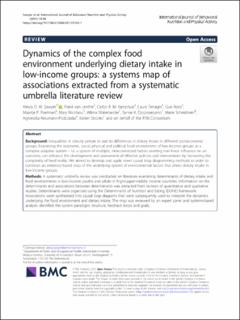| dc.contributor.author | Sawyer, Alexia | |
| dc.contributor.author | Lenthe, Frank van | |
| dc.contributor.author | Kamphuis, Carlijn B.M. | |
| dc.contributor.author | Terragni, Laura | |
| dc.contributor.author | Roos, Gun | |
| dc.contributor.author | Poelman, Maartje | |
| dc.contributor.author | Nicolaou, Mary | |
| dc.contributor.author | Waterlander, Wilma | |
| dc.contributor.author | Djojosoeparto, Sanne K. | |
| dc.contributor.author | Scheidmeir, Marie | |
| dc.contributor.author | Neumann-Podczaska, Agnieszka | |
| dc.contributor.author | Stronks, Karien | |
| dc.date.accessioned | 2021-09-30T14:02:39Z | |
| dc.date.available | 2021-09-30T14:02:39Z | |
| dc.date.created | 2021-08-09T10:51:14Z | |
| dc.date.issued | 2021-07-13 | |
| dc.identifier.issn | 1479-5868 | |
| dc.identifier.uri | https://hdl.handle.net/11250/2786712 | |
| dc.description.abstract | Background: Inequalities in obesity pertain in part to differences in dietary intake in different socioeconomic groups. Examining the economic, social, physical and political food environment of low-income groups as a complex adaptive system – i.e. a system of multiple, interconnected factors exerting non-linear influence on an outcome, can enhance the development and assessment of effective policies and interventions by honouring the complexity of lived reality. We aimed to develop and apply novel causal loop diagramming methods in order to construct an evidence-based map of the underlying system of environmental factors that drives dietary intake in low-income groups. Methods: A systematic umbrella review was conducted on literature examining determinants of dietary intake and food environments in low-income youths and adults in high/upper-middle income countries. Information on the determinants and associations between determinants was extracted from reviews of quantitative and qualitative studies. Determinants were organised using the Determinants of Nutrition and Eating (DONE) framework. Associations were synthesised into causal loop diagrams that were subsequently used to interpret the dynamics underlying the food environment and dietary intake. The map was reviewed by an expert panel and systems-based analysis identified the system paradigm, structure, feedback loops and goals. Results: Findings from forty-three reviews and expert consensus were synthesised in an evidence-based map of the complex adaptive system underlying the food environment influencing dietary intake in low-income groups. The system was interpreted as operating within a supply-and-demand, economic paradigm. Five sub-systems (‘geographical accessibility’, ‘household finances’, ‘household resources’, ‘individual influences’, ‘social and cultural influences’) were presented as causal loop diagrams comprising 60 variables, conveying goals which undermine healthy dietary intake. Conclusions: Our findings reveal how poor dietary intake in low-income groups can be presented as an emergent property of a complex adaptive system that sustains a food environment that increases the accessibility, availability, affordability and acceptability of unhealthy foods. In order to reshape system dynamics driving unhealthy food environments, simultaneous, diverse and innovative strategies are needed to facilitate longer-term management of household finances and socially-oriented practices around healthy food production, supply and intake. Ultimately, such strategies must be supported by a system paradigm which prioritises health. | en_US |
| dc.description.sponsorship | ADMS, FvL, LT, GR, MPP, SKD, MS and ANP were funded through the PEN project. The PEN project (www.jpi-pen.eu) is funded by the Joint Programming Initiative “A Healthy Diet for a Healthy Life” (JPI HDHL), a research and innovation initiative of EU member states and associated countries. The funding agencies supporting this work are (in alphabetical order of participating countries): France: Institut National de la Recherche Agronomique (INRA); Germany: Federal Ministry of Education and Research (BMBF); Ireland: Health Research Board (HRB); Italy: Ministry of Education, University and Research (MIUR); The Netherlands: The Netherlands Organisation for Health Research and Development (ZonMw); New Zealand: The University of Auckland, School of Population Health; Norway: The Research Council of Norway (RCN); Poland: The National Centre for Research and Development (NCBR). | en_US |
| dc.language.iso | eng | en_US |
| dc.publisher | BMC | en_US |
| dc.relation.ispartofseries | International Journal of Behavioral Nutrition and Physical Activity;18, Article number: 96 (2021) | |
| dc.rights | Navngivelse 4.0 Internasjonal | * |
| dc.rights.uri | http://creativecommons.org/licenses/by/4.0/deed.no | * |
| dc.subject | Diets | en_US |
| dc.subject | Low-income groups | en_US |
| dc.subject | Inequality | en_US |
| dc.subject | Food environments | en_US |
| dc.subject | Complex adaptive systems | en_US |
| dc.subject | System dynamics | en_US |
| dc.title | Dynamics of the complex food environment underlying dietary intake in low-income groups: a systems map of associations extracted from a systematic umbrella literature review. | en_US |
| dc.type | Peer reviewed | en_US |
| dc.type | Journal article | en_US |
| dc.description.version | publishedVersion | en_US |
| dc.rights.holder | © The Author(s). 2021 | en_US |
| dc.source.articlenumber | 96 | en_US |
| cristin.ispublished | true | |
| cristin.fulltext | original | |
| cristin.qualitycode | 2 | |
| dc.identifier.doi | https://doi.org/10.1186/s12966-021-01164-1 | |
| dc.identifier.cristin | 1924649 | |
| dc.source.journal | International Journal of Behavioral Nutrition and Physical Activity | en_US |
| dc.source.volume | 18 | en_US |
| dc.source.pagenumber | 1-21 | en_US |
| dc.relation.project | Norges forskningsråd: 297885 | en_US |

